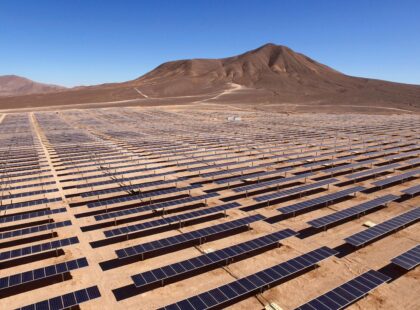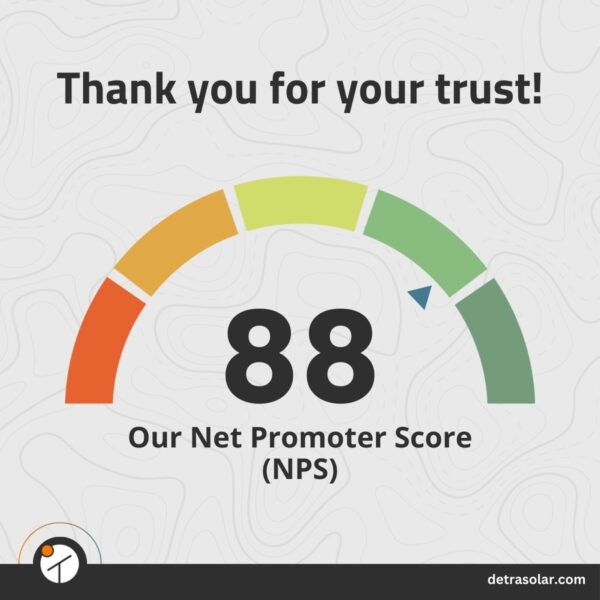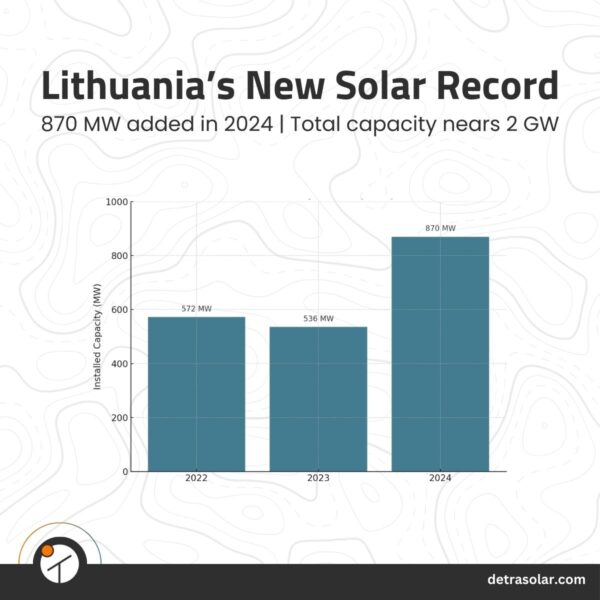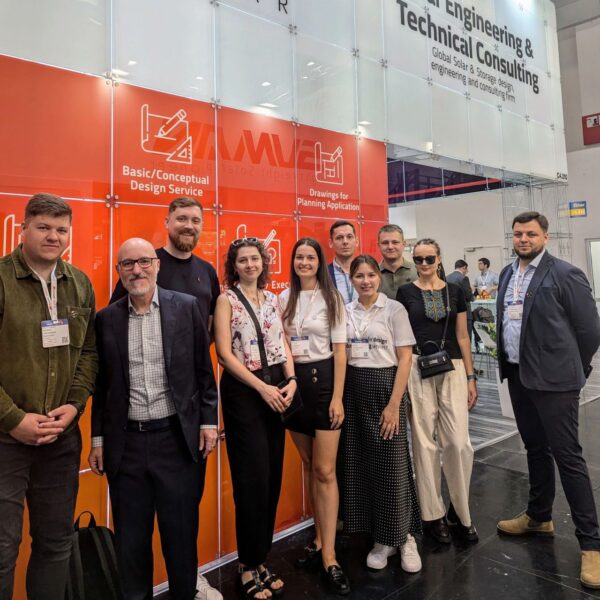Expert Insights: Upgrading Utility-Scale PV Projects with Battery Energy Storage Systems

By Ryszard Gornowicz, Energy Storage Specialist at Detra Solar.
Introduction: The Shift Toward Hybrid PV+BESS Systems
As the global energy transition accelerates, utility-scale photovoltaic (PV) power plants are evolving from pure generation assets into flexible energy hubs. A major step in that evolution is the integration of Battery Energy Storage Systems (BESS).
By retrofitting existing PV plants with BESS, asset owners and operators can unlock new revenue streams, improve grid compliance, and increase the overall value of their assets. However, integrating BESS into an operating solar site is not just a matter of dropping containers on-site—it requires careful technical design to ensure compatibility, performance, and long-term reliability.
At Detra Solar, we specialize in the technical design of PV and BESS infrastructure. In this article, we explore the key technical considerations for integrating BESS into existing PV projects—with a focus on the aspects where smart engineering makes all the difference.
Site Layout and Coupling Considerations for PV+BESS Integration
When adding BESS to an existing PV plant, the physical layout and electrical architecture of the site must be carefully considered together. Layout design is more than just finding free land—it requires holistic analysis followed by optimized equipment placement for operational safety, maintainability, and cost. At the same time, the choice between AC and DC coupling fundamentally shapes both the layout and interconnection strategy.
BESS Placement: Centralized vs Distributed
The placement of BESS equipment generally follows one of two strategies, closely linked to the electrical coupling mode:
- Centralized BESS placement: This approach locates all battery containers and their associated medium-voltage (MV) skids in a dedicated site area. It is typical for AC-coupled systems, where the BESS operates independently from the PV inverter and connects to the grid via its own inverter and transformer. Centralized layouts simplify maintenance, reduce trenching complexity, and support phased commissioning.
- Distributed BESS placement: This model is relevant primarily to DC-coupled systems, where battery units are electrically integrated upstream of a central inverter. While this setup can optimize energy capture—particularly by storing energy that would otherwise be clipped—it introduces layout and routing complexities. Distributed BESS is less common in retrofits due to the challenges of integrating with existing PV infrastructure.
AC vs. DC Coupling: Technical and Practical Considerations

- AC-Coupled Systems
- Technical: Separate inverters for PV and BESS; systems are electrically independent.
- Practical: Easier to retrofit; uses existing infrastructure with limited disruption.
- Economic: Slightly higher equipment costs, but more modular and flexible.
- Technical: Separate inverters for PV and BESS; systems are electrically independent.
- DC-Coupled Systems
- Technical: PV and BESS connect to the common DC bus inside the central inverter.
- Practical: Usually requires significant modification of the existing inverter and LV auxiliary supply infrastructure
- Economic: Potential for higher round-trip efficiency, clipping recovery, and lower CAPEX, but less suited for retrofits due to complexity.
- Technical: PV and BESS connect to the common DC bus inside the central inverter.
At Detra Solar, we work with clients to optimize layouts based on the coupling strategy selected, taking into account interconnection paths, inverter configuration, and site topography.
Key Layout Considerations in Retrofits
- Space constraints: Is there enough room for battery enclosures, PCSs, MV Skids, and fire access zones?
- Topography: Is the available area for BESS flat, or will it require extensive ground grading?
- Access for construction and maintenance: Will there be sufficient clearance for crane access, delivery vehicles, and long-term operation?
- Shading sensitivity: Will the new BESS infrastructure cast shadows on PV arrays?
- Integration with existing infrastructure: How will the new system fit into the existing trench paths, fencing, access roads, and drainage systems, and how to plan it to minimize redesigns?
Electrical and Cable Infrastructure Design in PV+BESS Retrofits
Upgrading an existing PV plant with a battery energy storage system (BESS) brings both opportunities and complexity—especially in how the site’s electrical and underground infrastructure must adapt. From new power flows and load scenarios to rerouted cabling and trenching, the success of the integration depends heavily on precise, well-coordinated design.
At Detra Solar, we support PV+BESS hybridization by combining detailed electrical calculations with practical, construction-ready cable routing and trenching designs—ensuring safety, performance, and cost-efficiency.
Electrical Considerations for Hybrid PV+BESS Systems
The addition of BESS introduces new current paths, dynamic loads, and potential operating conflicts—particularly when PV and BESS assets share transformers, switchgear, or medium-voltage infrastructure. To address these challenges, the designs must account for:
- Cable sizing: Conductors must accommodate updated load profiles, including BESS discharge currents and charging cycles, which differ significantly from the steady daytime generation of PV. For AC-coupled systems, cables typically run from centralized BESS containers to MV transformers, often requiring longer trench routes. In DC-coupled systems, shorter, distributed cable runs are common—but demand careful thermal consideration due to higher current density near the PV field.
- Voltage level matching: Ensuring voltage compatibility between PV and BESS systems is critical to avoid inefficient operation or system faults. In AC-coupled setups, this is relatively straightforward—both the PV and BESS inverters must simply produce the same AC output voltage at the point of common coupling (PCC). However, for DC-coupled configurations, voltage alignment is more complex. Since both the PV array and the BESS are connected to a shared DC bus, a DC-DC converter is often required to match operating voltages and manage power flow efficiently. Without proper voltage coordination, system safety, performance, and reliability can be compromised.
- Integration with existing systems: Retrofitting can stress legacy components. It is important to ensure that new loads remain within safe operating margins and identify where equipment upgrades or reinforcements are required.
- Dynamic operating conditions: Unlike PV systems, which only generate during daylight hours, BESS can operate 24/7—charging at night and discharging during peak demand. The designed equipment must withstand fluctuating thermal and electrical stress throughout the full operational cycle.
Cable Routing and Trenching in Retrofitted Sites
Retrofitting BESS often means threading new infrastructure through an already built and energized environment. That’s why our cable routing and trenching strategy emphasizes coordination, efficiency, and safety:
- Route optimization: We minimize trench lengths while avoiding existing services, foundations, and duct banks. Efficient routing reduces cost, installation time, and risk of rework.
- Phased execution: Cable installation is planned to avoid disrupting ongoing PV operations, with construction stages aligned to minimize downtime and maintain site safety.
- Clash-free coordination: By integrating site survey data, as-built records, and EPC input, we create trenching layouts that avoid underground clashes and reduce the risk of costly field revisions.
By aligning structural and electrical layouts with the selected coupling strategy—and the realities of existing site infrastructure—we help clients deliver PV+BESS retrofits that are technically sound and economically practical.
Interfacing with Grid and HV Systems
It’s important to acknowledge the role of high-voltage engineering or grid compliance studies in any BESS retrofit project. Connecting new energy storage assets to an existing grid-tied PV system can impact:
- Grid compliance: A revised connection agreement or updated grid study may be required.
- HV infrastructure: Additional transformers, switchgear, or protective devices may be needed depending on how the BESS is integrated.
- Protection settings: Coordinating relays and protections between PV and BESS systems is essential for safe operation.
We recommend involving a grid consultant and HV specialist early in the retrofit planning phase to address these considerations in parallel with the site layout design.
Construction Phasing and On-Site Coordination
Retrofitting a BESS into an operational PV plant requires careful coordination to avoid disruption and ensure the safety of construction teams and operational personnel. At Detra Solar, we design with phasing in mind from the beginning.
Practical Phasing Strategies We Support:
- Zoning the construction work to isolate trenching and equipment delivery from energized areas.
- Planning around shutdown windows, if temporary outages are required for connections.
- Using existing documentation such as as-built drawings to avoid surprises.
- Integrating access plans for heavy machinery like cranes and transport trucks during the BESS construction phase.
By designing with the operational constraints in mind, we help EPCs and developers reduce risk and maintain uptime throughout the retrofit process.
Conclusion: Smart Design Enables Smarter Solar
Integrating BESS into an existing utility-scale PV plant is a powerful way to increase energy value, site flexibility, and long-term profitability. But achieving that value requires much more than simply installing batteries. It takes careful technical design, particularly in areas like site layout, cable routing, and electrical integration.
At Detra Solar, we specialize in delivering that level of design detail—helping project developers and EPCs plan and execute PV+BESS retrofits that are efficient, reliable, and future-ready.
Interested in retrofitting a PV plant with BESS?
Contact our team to learn how Detra Solar can support your project with optimized layouts, accurate designs, and trusted engineering expertise.







